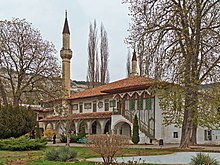Big Khan Mosque
| The Big Khan Mosque | |
|---|---|
 | |
| Religion | |
| Affiliation | Islam |
| Rite | Sunni |
| Status | Active |
| Location | |
| Location | Bakhchisaray |
| State | Disputed between Russia and Ukraine[1] |
| Territory | |
| Geographic coordinates | 44°44′55.22″N 33°52′55.06″E / 44.7486722°N 33.8819611°ECoordinates: 44°44′55.22″N 33°52′55.06″E / 44.7486722°N 33.8819611°E |
| Architecture | |
| Type | Mosque |
| Style | Ottoman architecture |
| Completed | 1532 |
| Specifications | |
| Minaret(s) | 2 |
| Minaret height | 28 meters |
| Materials | ... |
The Big Khan Mosque (Crimean Tatar: Büyük Han Cami, Ukrainian: Велика ханська мечеть, Turkish: Büyük Han Camii) is located in Bakhchisaray, Crimea, Disputed between Russia and Ukraine[1] and is part of the Bakhchisaray Palace. It is one of the largest mosques in the Crimea and one of the first buildings of the Khan's palace. The mosque was built in 1532 by Sahib I Giray and bore his name in the 17th century.
History[]
The mosque consists of a three-aisle square prayer hall covered with a hipped roof, a narthex and porticos facing east and west. Two symmetrical octagonal minarets rise through the porticos; they are twenty-eight meters high and have conical caps and finials. A domed wudu kiosk of square shape is attached to the northeastern corner of the mosque. It is believed that a madrasah built by Khan in 1750 used to adjoin the eastern wall. The mosque is entered from a portal facing north. Inside, a balcony is attached to three of the four walls, part of which is sectioned off for the Khan's lodge. Scholars argue that the mosque was originally roofed with domes of various sizes.[2]
In 1736 the mosque was damaged by fire and later restored during the reign of Khan Selameta Giray.
See also[]
References[]
- ^ a b This place is located on the Crimean peninsula, most of which is the subject of a territorial dispute between Russia, which administers the contested area, and Ukraine, whose internationally recognised boundaries include the contested area. According to the political division of Russia, there are federal subjects of the Russian Federation (the Republic of Crimea and the federal city of Sevastopol) located on the peninsula. According to the administrative-territorial division of Ukraine, there are the Ukrainian divisions (the Autonomous Republic of Crimea and the city with special status of Sevastopol) located on the peninsula.
- ^ "Tatar Khans' Palace". ArchNet. Retrieved 2011-02-21.
| Wikimedia Commons has media related to Big mosque in Bakhchisaray Palace. |
- Mosques in Bakhchysarai
- Religious buildings and structures completed in 1532
- 16th-century mosques
- 1532 establishments in Europe
- Crimea stubs
- European mosque stubs


